Underrepresented Groups in Organizations
VerifiedAdded on 2020/02/05
|16
|3653
|690
AI Summary
This assignment delves into the issue of underrepresentation within organizations, focusing on groups who experience disproportionately low participation due to protected characteristics. It explores how these characteristics can lead to barriers and necessitates addressing the particular needs of such groups to ensure equitable and inclusive organizational structures.
Contribute Materials
Your contribution can guide someone’s learning journey. Share your
documents today.
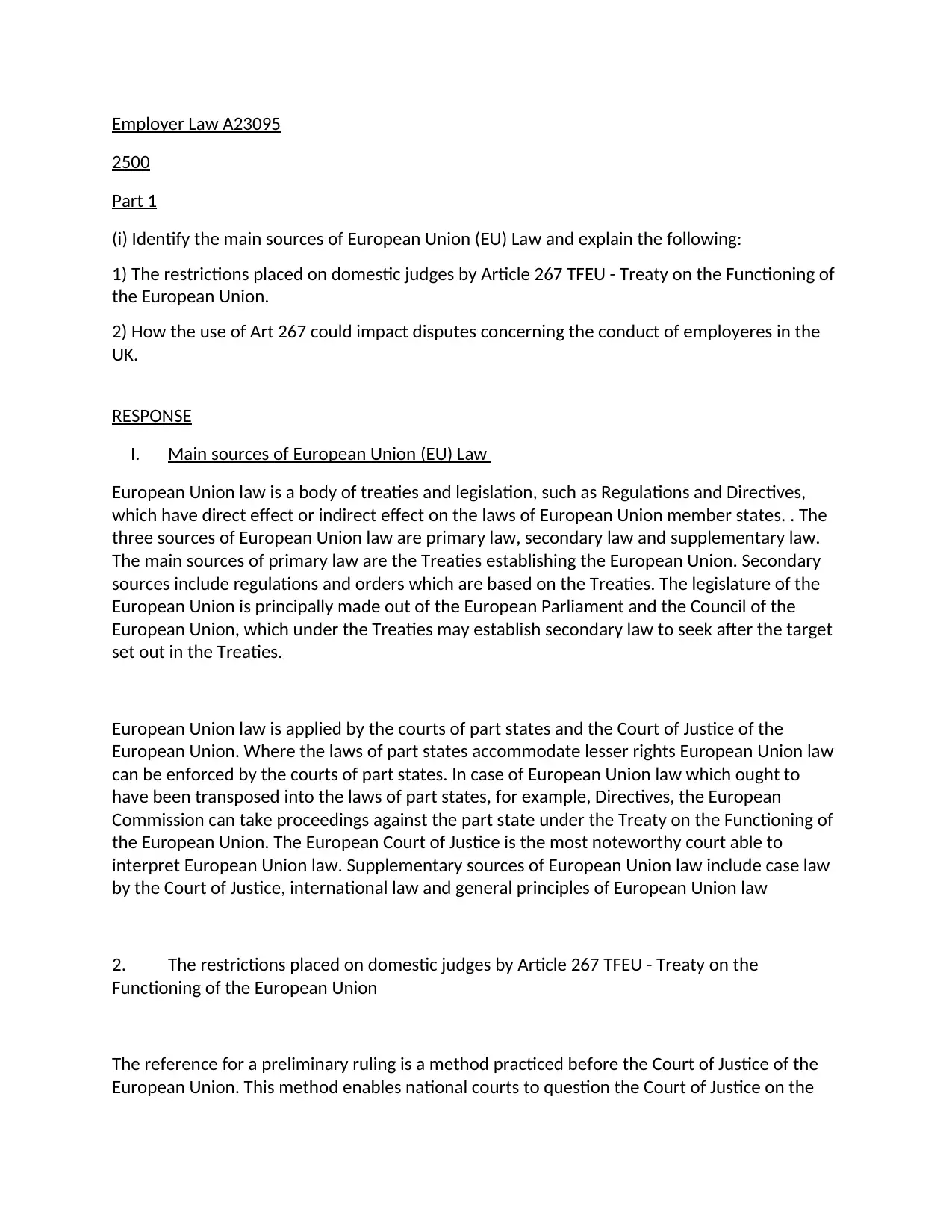
Employer Law A23095
2500
Part 1
(i) Identify the main sources of European Union (EU) Law and explain the following:
1) The restrictions placed on domestic judges by Article 267 TFEU - Treaty on the Functioning of
the European Union.
2) How the use of Art 267 could impact disputes concerning the conduct of employeres in the
UK.
RESPONSE
I. Main sources of European Union (EU) Law
European Union law is a body of treaties and legislation, such as Regulations and Directives,
which have direct effect or indirect effect on the laws of European Union member states. . The
three sources of European Union law are primary law, secondary law and supplementary law.
The main sources of primary law are the Treaties establishing the European Union. Secondary
sources include regulations and orders which are based on the Treaties. The legislature of the
European Union is principally made out of the European Parliament and the Council of the
European Union, which under the Treaties may establish secondary law to seek after the target
set out in the Treaties.
European Union law is applied by the courts of part states and the Court of Justice of the
European Union. Where the laws of part states accommodate lesser rights European Union law
can be enforced by the courts of part states. In case of European Union law which ought to
have been transposed into the laws of part states, for example, Directives, the European
Commission can take proceedings against the part state under the Treaty on the Functioning of
the European Union. The European Court of Justice is the most noteworthy court able to
interpret European Union law. Supplementary sources of European Union law include case law
by the Court of Justice, international law and general principles of European Union law
2. The restrictions placed on domestic judges by Article 267 TFEU - Treaty on the
Functioning of the European Union
The reference for a preliminary ruling is a method practiced before the Court of Justice of the
European Union. This method enables national courts to question the Court of Justice on the
2500
Part 1
(i) Identify the main sources of European Union (EU) Law and explain the following:
1) The restrictions placed on domestic judges by Article 267 TFEU - Treaty on the Functioning of
the European Union.
2) How the use of Art 267 could impact disputes concerning the conduct of employeres in the
UK.
RESPONSE
I. Main sources of European Union (EU) Law
European Union law is a body of treaties and legislation, such as Regulations and Directives,
which have direct effect or indirect effect on the laws of European Union member states. . The
three sources of European Union law are primary law, secondary law and supplementary law.
The main sources of primary law are the Treaties establishing the European Union. Secondary
sources include regulations and orders which are based on the Treaties. The legislature of the
European Union is principally made out of the European Parliament and the Council of the
European Union, which under the Treaties may establish secondary law to seek after the target
set out in the Treaties.
European Union law is applied by the courts of part states and the Court of Justice of the
European Union. Where the laws of part states accommodate lesser rights European Union law
can be enforced by the courts of part states. In case of European Union law which ought to
have been transposed into the laws of part states, for example, Directives, the European
Commission can take proceedings against the part state under the Treaty on the Functioning of
the European Union. The European Court of Justice is the most noteworthy court able to
interpret European Union law. Supplementary sources of European Union law include case law
by the Court of Justice, international law and general principles of European Union law
2. The restrictions placed on domestic judges by Article 267 TFEU - Treaty on the
Functioning of the European Union
The reference for a preliminary ruling is a method practiced before the Court of Justice of the
European Union. This method enables national courts to question the Court of Justice on the
Secure Best Marks with AI Grader
Need help grading? Try our AI Grader for instant feedback on your assignments.
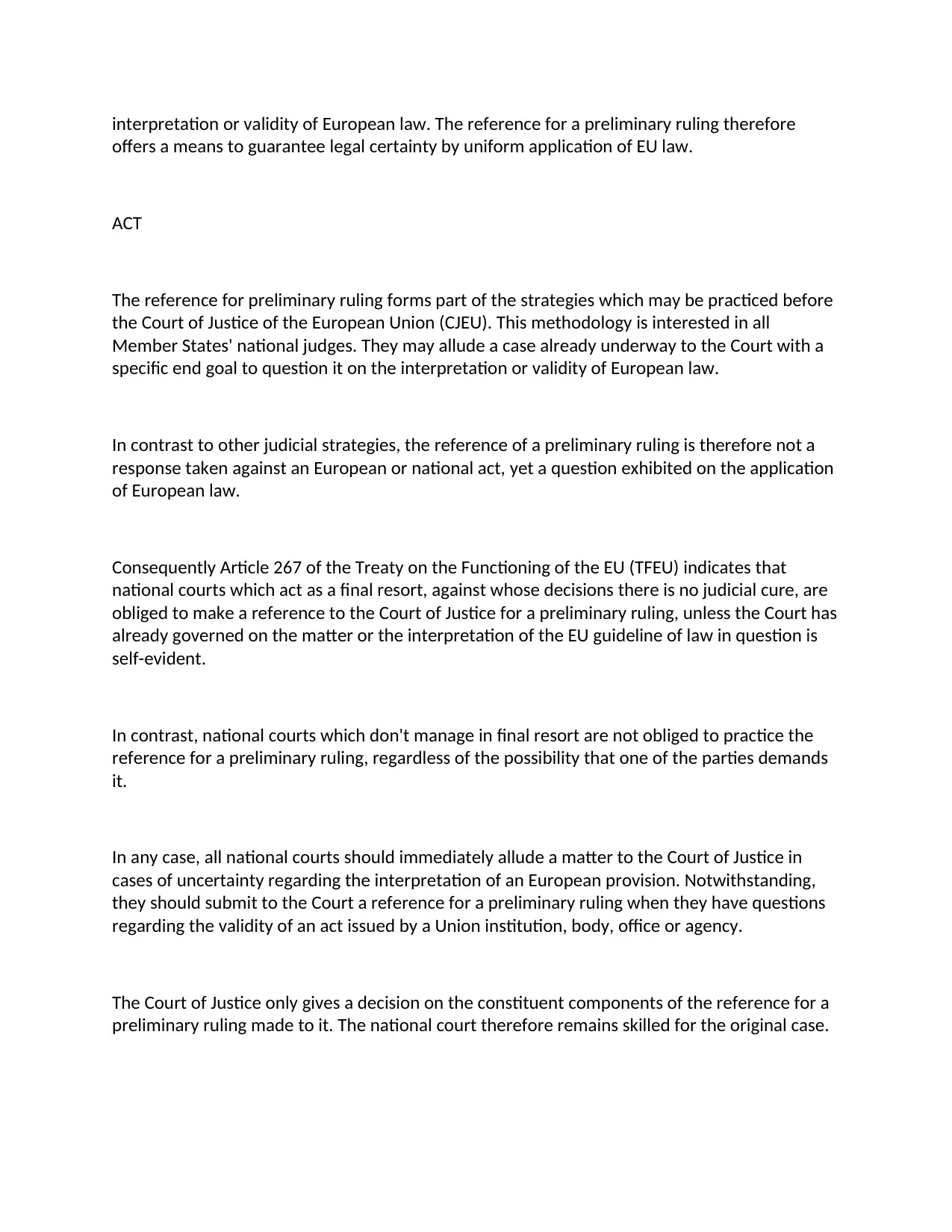
interpretation or validity of European law. The reference for a preliminary ruling therefore
offers a means to guarantee legal certainty by uniform application of EU law.
ACT
The reference for preliminary ruling forms part of the strategies which may be practiced before
the Court of Justice of the European Union (CJEU). This methodology is interested in all
Member States' national judges. They may allude a case already underway to the Court with a
specific end goal to question it on the interpretation or validity of European law.
In contrast to other judicial strategies, the reference of a preliminary ruling is therefore not a
response taken against an European or national act, yet a question exhibited on the application
of European law.
Consequently Article 267 of the Treaty on the Functioning of the EU (TFEU) indicates that
national courts which act as a final resort, against whose decisions there is no judicial cure, are
obliged to make a reference to the Court of Justice for a preliminary ruling, unless the Court has
already governed on the matter or the interpretation of the EU guideline of law in question is
self-evident.
In contrast, national courts which don't manage in final resort are not obliged to practice the
reference for a preliminary ruling, regardless of the possibility that one of the parties demands
it.
In any case, all national courts should immediately allude a matter to the Court of Justice in
cases of uncertainty regarding the interpretation of an European provision. Notwithstanding,
they should submit to the Court a reference for a preliminary ruling when they have questions
regarding the validity of an act issued by a Union institution, body, office or agency.
The Court of Justice only gives a decision on the constituent components of the reference for a
preliminary ruling made to it. The national court therefore remains skilled for the original case.
offers a means to guarantee legal certainty by uniform application of EU law.
ACT
The reference for preliminary ruling forms part of the strategies which may be practiced before
the Court of Justice of the European Union (CJEU). This methodology is interested in all
Member States' national judges. They may allude a case already underway to the Court with a
specific end goal to question it on the interpretation or validity of European law.
In contrast to other judicial strategies, the reference of a preliminary ruling is therefore not a
response taken against an European or national act, yet a question exhibited on the application
of European law.
Consequently Article 267 of the Treaty on the Functioning of the EU (TFEU) indicates that
national courts which act as a final resort, against whose decisions there is no judicial cure, are
obliged to make a reference to the Court of Justice for a preliminary ruling, unless the Court has
already governed on the matter or the interpretation of the EU guideline of law in question is
self-evident.
In contrast, national courts which don't manage in final resort are not obliged to practice the
reference for a preliminary ruling, regardless of the possibility that one of the parties demands
it.
In any case, all national courts should immediately allude a matter to the Court of Justice in
cases of uncertainty regarding the interpretation of an European provision. Notwithstanding,
they should submit to the Court a reference for a preliminary ruling when they have questions
regarding the validity of an act issued by a Union institution, body, office or agency.
The Court of Justice only gives a decision on the constituent components of the reference for a
preliminary ruling made to it. The national court therefore remains skilled for the original case.
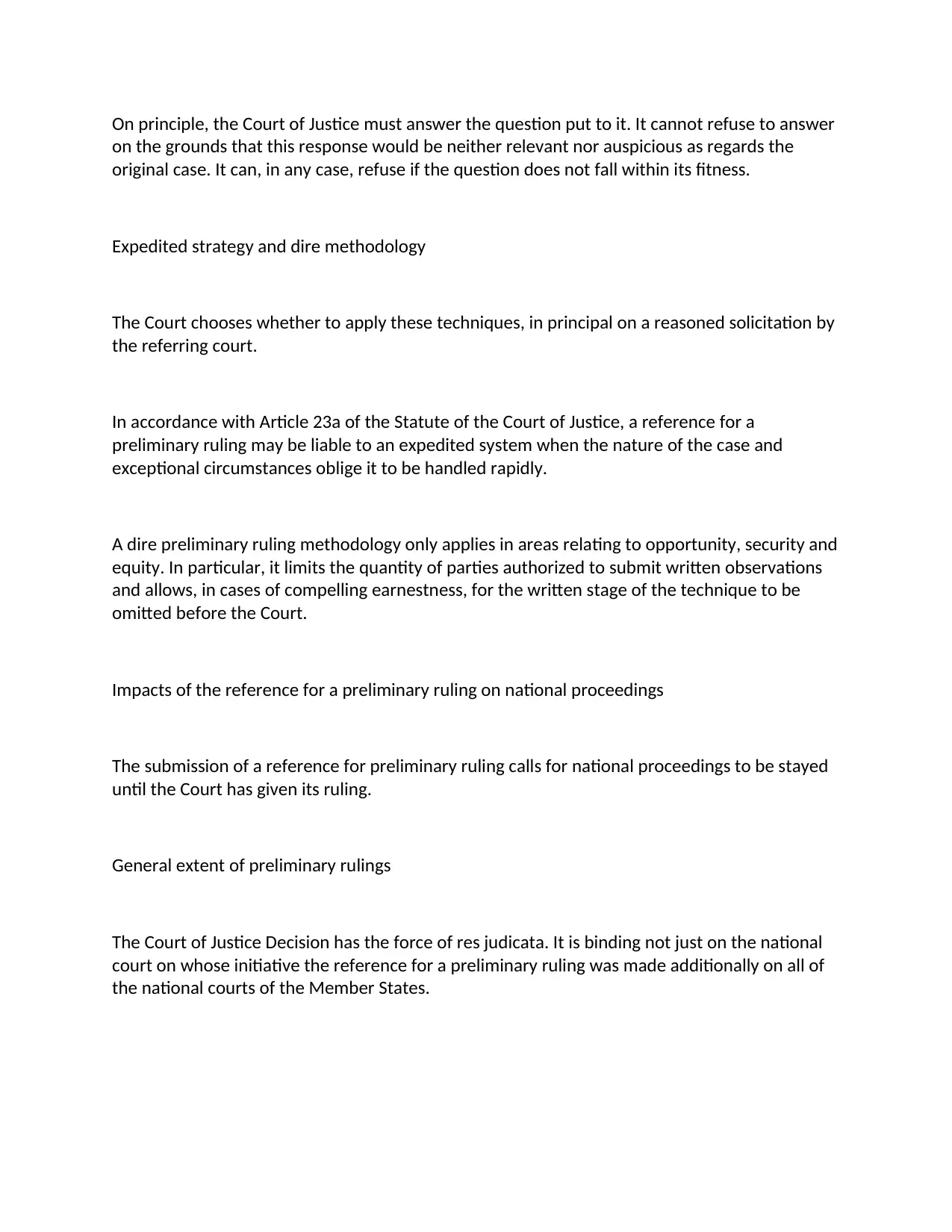
On principle, the Court of Justice must answer the question put to it. It cannot refuse to answer
on the grounds that this response would be neither relevant nor auspicious as regards the
original case. It can, in any case, refuse if the question does not fall within its fitness.
Expedited strategy and dire methodology
The Court chooses whether to apply these techniques, in principal on a reasoned solicitation by
the referring court.
In accordance with Article 23a of the Statute of the Court of Justice, a reference for a
preliminary ruling may be liable to an expedited system when the nature of the case and
exceptional circumstances oblige it to be handled rapidly.
A dire preliminary ruling methodology only applies in areas relating to opportunity, security and
equity. In particular, it limits the quantity of parties authorized to submit written observations
and allows, in cases of compelling earnestness, for the written stage of the technique to be
omitted before the Court.
Impacts of the reference for a preliminary ruling on national proceedings
The submission of a reference for preliminary ruling calls for national proceedings to be stayed
until the Court has given its ruling.
General extent of preliminary rulings
The Court of Justice Decision has the force of res judicata. It is binding not just on the national
court on whose initiative the reference for a preliminary ruling was made additionally on all of
the national courts of the Member States.
on the grounds that this response would be neither relevant nor auspicious as regards the
original case. It can, in any case, refuse if the question does not fall within its fitness.
Expedited strategy and dire methodology
The Court chooses whether to apply these techniques, in principal on a reasoned solicitation by
the referring court.
In accordance with Article 23a of the Statute of the Court of Justice, a reference for a
preliminary ruling may be liable to an expedited system when the nature of the case and
exceptional circumstances oblige it to be handled rapidly.
A dire preliminary ruling methodology only applies in areas relating to opportunity, security and
equity. In particular, it limits the quantity of parties authorized to submit written observations
and allows, in cases of compelling earnestness, for the written stage of the technique to be
omitted before the Court.
Impacts of the reference for a preliminary ruling on national proceedings
The submission of a reference for preliminary ruling calls for national proceedings to be stayed
until the Court has given its ruling.
General extent of preliminary rulings
The Court of Justice Decision has the force of res judicata. It is binding not just on the national
court on whose initiative the reference for a preliminary ruling was made additionally on all of
the national courts of the Member States.

In the context of a reference for a preliminary ruling concerning validity, if the European
instrument is declared invalid all of the instruments adopted based on it are also invalid. It then
falls to the capable European institutions to adopt another instrument to amend the situation.
3. How the use of Art 267 could impact disputes concerning the conduct of employeres in
the UK.
Article 267 of the Treaty on the Functioning of the European Union (TFEU), and the preliminary
ruling method it accommodates, have a critical impact on the harmonious improvement of EU
law and the way in which national and EU legal frameworks interact and communicate. It is
considered 'by far the most important aspect of the judicial arrangement of the Community'.
The methodology has given a platform to the Court of Justice of the European Union (CJEU) to
convey seminal constitutional decisions that define the relationship between the EU and part
states. On the other hand, it has been argued that the use of Article 267 has been
overextended in various ways, for example, by pushing the boundaries of the sort of bodies
which can allude. This can lead to low quality rulings because of an overwhelming of the Court.
The main reason for the preliminary ruling methodology is 'to keep the event within the
Community of divergences in judicial decisions on questions of Community law', ensuring
uniform interpretation of EU legal provisions across the 27 part states. As more than 50 for
every penny of the CJEU's workload, it has brought a large group of issues which the CJEU may
not have had the opportunity to consider otherwise. It has allowed the court to create
fundamental principles of EU law, including direct impact, supremacy, indirect impact (i.e. the
interpretation of national law in line with mandates) and part state liability for breach of EU
law.
Part 2
(ii) Identify the different forms of Alternative Dispute Resolution (ADR), and state which forms
of ADR are typically used for employment related disputes. Discuss the benefits of using ADR in
employment related disputes, and the role ACAS occupies in resolving these disputes.
RESPONSE
instrument is declared invalid all of the instruments adopted based on it are also invalid. It then
falls to the capable European institutions to adopt another instrument to amend the situation.
3. How the use of Art 267 could impact disputes concerning the conduct of employeres in
the UK.
Article 267 of the Treaty on the Functioning of the European Union (TFEU), and the preliminary
ruling method it accommodates, have a critical impact on the harmonious improvement of EU
law and the way in which national and EU legal frameworks interact and communicate. It is
considered 'by far the most important aspect of the judicial arrangement of the Community'.
The methodology has given a platform to the Court of Justice of the European Union (CJEU) to
convey seminal constitutional decisions that define the relationship between the EU and part
states. On the other hand, it has been argued that the use of Article 267 has been
overextended in various ways, for example, by pushing the boundaries of the sort of bodies
which can allude. This can lead to low quality rulings because of an overwhelming of the Court.
The main reason for the preliminary ruling methodology is 'to keep the event within the
Community of divergences in judicial decisions on questions of Community law', ensuring
uniform interpretation of EU legal provisions across the 27 part states. As more than 50 for
every penny of the CJEU's workload, it has brought a large group of issues which the CJEU may
not have had the opportunity to consider otherwise. It has allowed the court to create
fundamental principles of EU law, including direct impact, supremacy, indirect impact (i.e. the
interpretation of national law in line with mandates) and part state liability for breach of EU
law.
Part 2
(ii) Identify the different forms of Alternative Dispute Resolution (ADR), and state which forms
of ADR are typically used for employment related disputes. Discuss the benefits of using ADR in
employment related disputes, and the role ACAS occupies in resolving these disputes.
RESPONSE
Secure Best Marks with AI Grader
Need help grading? Try our AI Grader for instant feedback on your assignments.
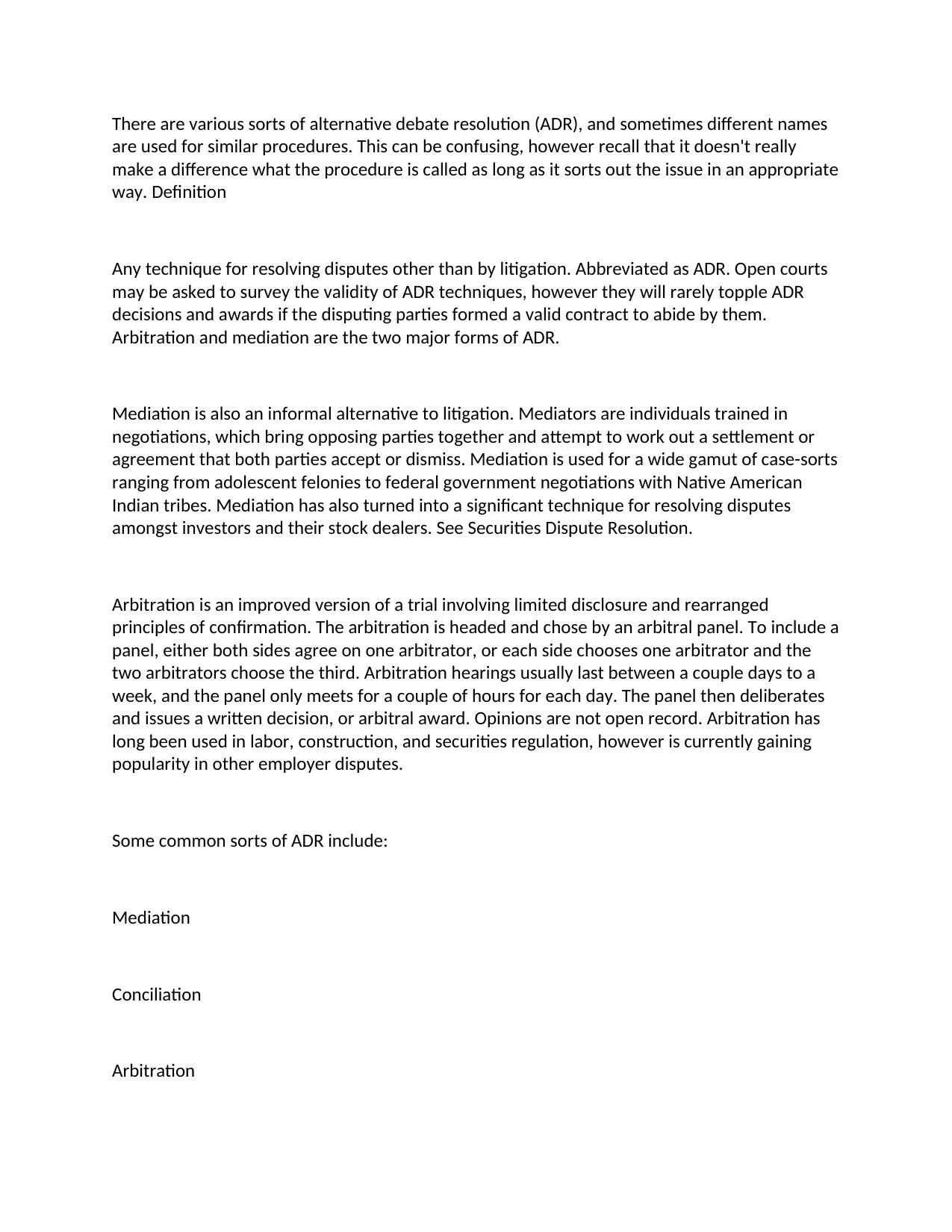
There are various sorts of alternative debate resolution (ADR), and sometimes different names
are used for similar procedures. This can be confusing, however recall that it doesn't really
make a difference what the procedure is called as long as it sorts out the issue in an appropriate
way. Definition
Any technique for resolving disputes other than by litigation. Abbreviated as ADR. Open courts
may be asked to survey the validity of ADR techniques, however they will rarely topple ADR
decisions and awards if the disputing parties formed a valid contract to abide by them.
Arbitration and mediation are the two major forms of ADR.
Mediation is also an informal alternative to litigation. Mediators are individuals trained in
negotiations, which bring opposing parties together and attempt to work out a settlement or
agreement that both parties accept or dismiss. Mediation is used for a wide gamut of case-sorts
ranging from adolescent felonies to federal government negotiations with Native American
Indian tribes. Mediation has also turned into a significant technique for resolving disputes
amongst investors and their stock dealers. See Securities Dispute Resolution.
Arbitration is an improved version of a trial involving limited disclosure and rearranged
principles of confirmation. The arbitration is headed and chose by an arbitral panel. To include a
panel, either both sides agree on one arbitrator, or each side chooses one arbitrator and the
two arbitrators choose the third. Arbitration hearings usually last between a couple days to a
week, and the panel only meets for a couple of hours for each day. The panel then deliberates
and issues a written decision, or arbitral award. Opinions are not open record. Arbitration has
long been used in labor, construction, and securities regulation, however is currently gaining
popularity in other employer disputes.
Some common sorts of ADR include:
Mediation
Conciliation
Arbitration
are used for similar procedures. This can be confusing, however recall that it doesn't really
make a difference what the procedure is called as long as it sorts out the issue in an appropriate
way. Definition
Any technique for resolving disputes other than by litigation. Abbreviated as ADR. Open courts
may be asked to survey the validity of ADR techniques, however they will rarely topple ADR
decisions and awards if the disputing parties formed a valid contract to abide by them.
Arbitration and mediation are the two major forms of ADR.
Mediation is also an informal alternative to litigation. Mediators are individuals trained in
negotiations, which bring opposing parties together and attempt to work out a settlement or
agreement that both parties accept or dismiss. Mediation is used for a wide gamut of case-sorts
ranging from adolescent felonies to federal government negotiations with Native American
Indian tribes. Mediation has also turned into a significant technique for resolving disputes
amongst investors and their stock dealers. See Securities Dispute Resolution.
Arbitration is an improved version of a trial involving limited disclosure and rearranged
principles of confirmation. The arbitration is headed and chose by an arbitral panel. To include a
panel, either both sides agree on one arbitrator, or each side chooses one arbitrator and the
two arbitrators choose the third. Arbitration hearings usually last between a couple days to a
week, and the panel only meets for a couple of hours for each day. The panel then deliberates
and issues a written decision, or arbitral award. Opinions are not open record. Arbitration has
long been used in labor, construction, and securities regulation, however is currently gaining
popularity in other employer disputes.
Some common sorts of ADR include:
Mediation
Conciliation
Arbitration
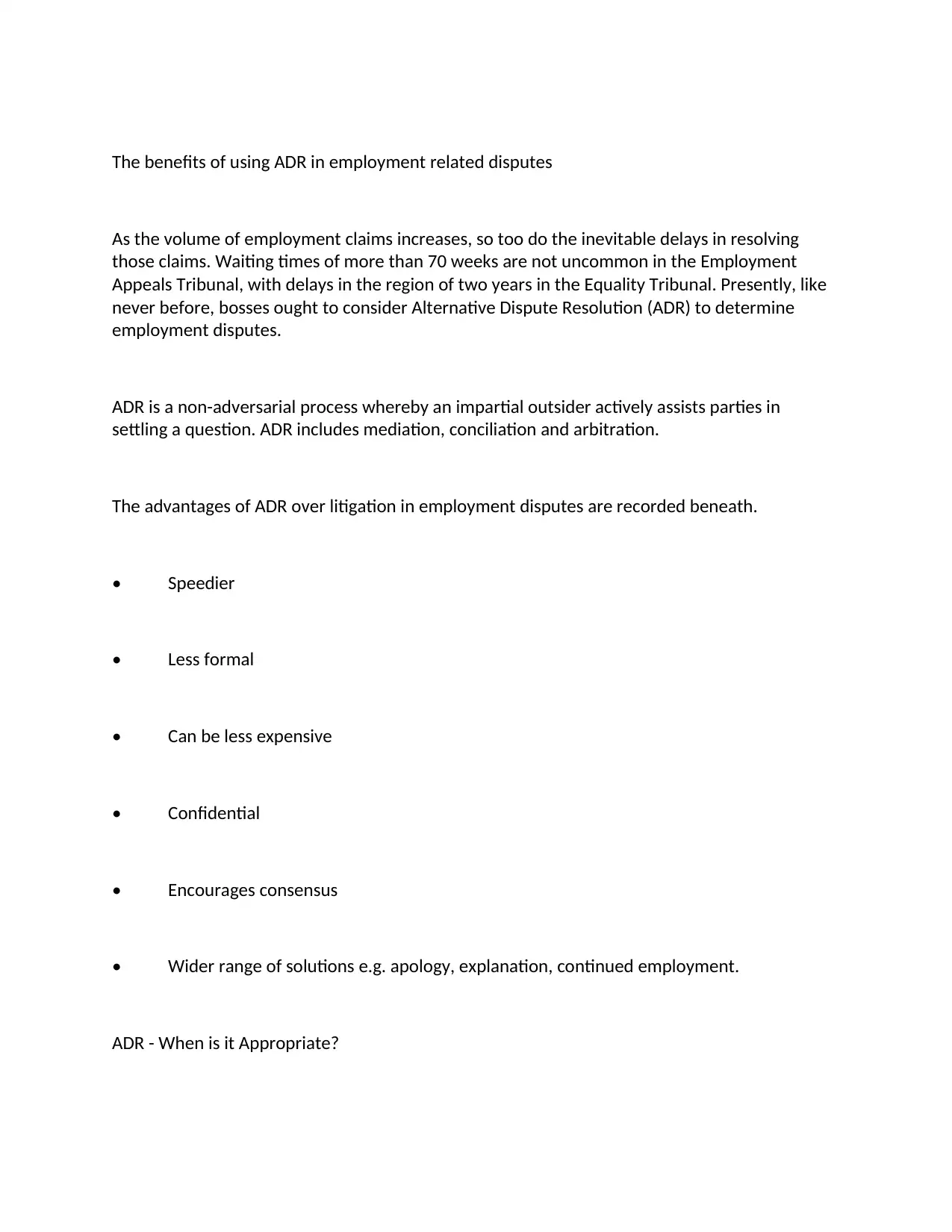
The benefits of using ADR in employment related disputes
As the volume of employment claims increases, so too do the inevitable delays in resolving
those claims. Waiting times of more than 70 weeks are not uncommon in the Employment
Appeals Tribunal, with delays in the region of two years in the Equality Tribunal. Presently, like
never before, bosses ought to consider Alternative Dispute Resolution (ADR) to determine
employment disputes.
ADR is a non-adversarial process whereby an impartial outsider actively assists parties in
settling a question. ADR includes mediation, conciliation and arbitration.
The advantages of ADR over litigation in employment disputes are recorded beneath.
• Speedier
• Less formal
• Can be less expensive
• Confidential
• Encourages consensus
• Wider range of solutions e.g. apology, explanation, continued employment.
ADR - When is it Appropriate?
As the volume of employment claims increases, so too do the inevitable delays in resolving
those claims. Waiting times of more than 70 weeks are not uncommon in the Employment
Appeals Tribunal, with delays in the region of two years in the Equality Tribunal. Presently, like
never before, bosses ought to consider Alternative Dispute Resolution (ADR) to determine
employment disputes.
ADR is a non-adversarial process whereby an impartial outsider actively assists parties in
settling a question. ADR includes mediation, conciliation and arbitration.
The advantages of ADR over litigation in employment disputes are recorded beneath.
• Speedier
• Less formal
• Can be less expensive
• Confidential
• Encourages consensus
• Wider range of solutions e.g. apology, explanation, continued employment.
ADR - When is it Appropriate?
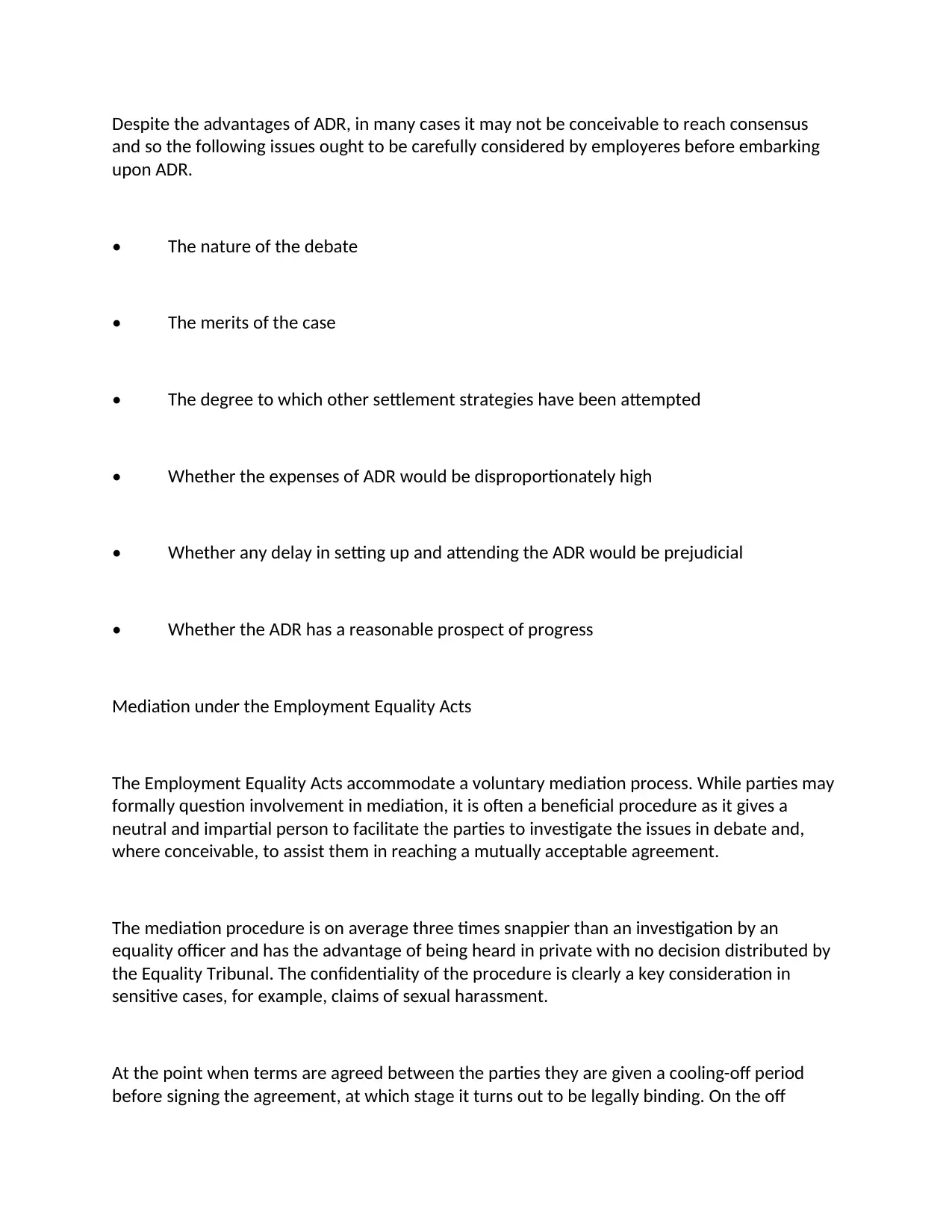
Despite the advantages of ADR, in many cases it may not be conceivable to reach consensus
and so the following issues ought to be carefully considered by employeres before embarking
upon ADR.
• The nature of the debate
• The merits of the case
• The degree to which other settlement strategies have been attempted
• Whether the expenses of ADR would be disproportionately high
• Whether any delay in setting up and attending the ADR would be prejudicial
• Whether the ADR has a reasonable prospect of progress
Mediation under the Employment Equality Acts
The Employment Equality Acts accommodate a voluntary mediation process. While parties may
formally question involvement in mediation, it is often a beneficial procedure as it gives a
neutral and impartial person to facilitate the parties to investigate the issues in debate and,
where conceivable, to assist them in reaching a mutually acceptable agreement.
The mediation procedure is on average three times snappier than an investigation by an
equality officer and has the advantage of being heard in private with no decision distributed by
the Equality Tribunal. The confidentiality of the procedure is clearly a key consideration in
sensitive cases, for example, claims of sexual harassment.
At the point when terms are agreed between the parties they are given a cooling-off period
before signing the agreement, at which stage it turns out to be legally binding. On the off
and so the following issues ought to be carefully considered by employeres before embarking
upon ADR.
• The nature of the debate
• The merits of the case
• The degree to which other settlement strategies have been attempted
• Whether the expenses of ADR would be disproportionately high
• Whether any delay in setting up and attending the ADR would be prejudicial
• Whether the ADR has a reasonable prospect of progress
Mediation under the Employment Equality Acts
The Employment Equality Acts accommodate a voluntary mediation process. While parties may
formally question involvement in mediation, it is often a beneficial procedure as it gives a
neutral and impartial person to facilitate the parties to investigate the issues in debate and,
where conceivable, to assist them in reaching a mutually acceptable agreement.
The mediation procedure is on average three times snappier than an investigation by an
equality officer and has the advantage of being heard in private with no decision distributed by
the Equality Tribunal. The confidentiality of the procedure is clearly a key consideration in
sensitive cases, for example, claims of sexual harassment.
At the point when terms are agreed between the parties they are given a cooling-off period
before signing the agreement, at which stage it turns out to be legally binding. On the off
Paraphrase This Document
Need a fresh take? Get an instant paraphrase of this document with our AI Paraphraser
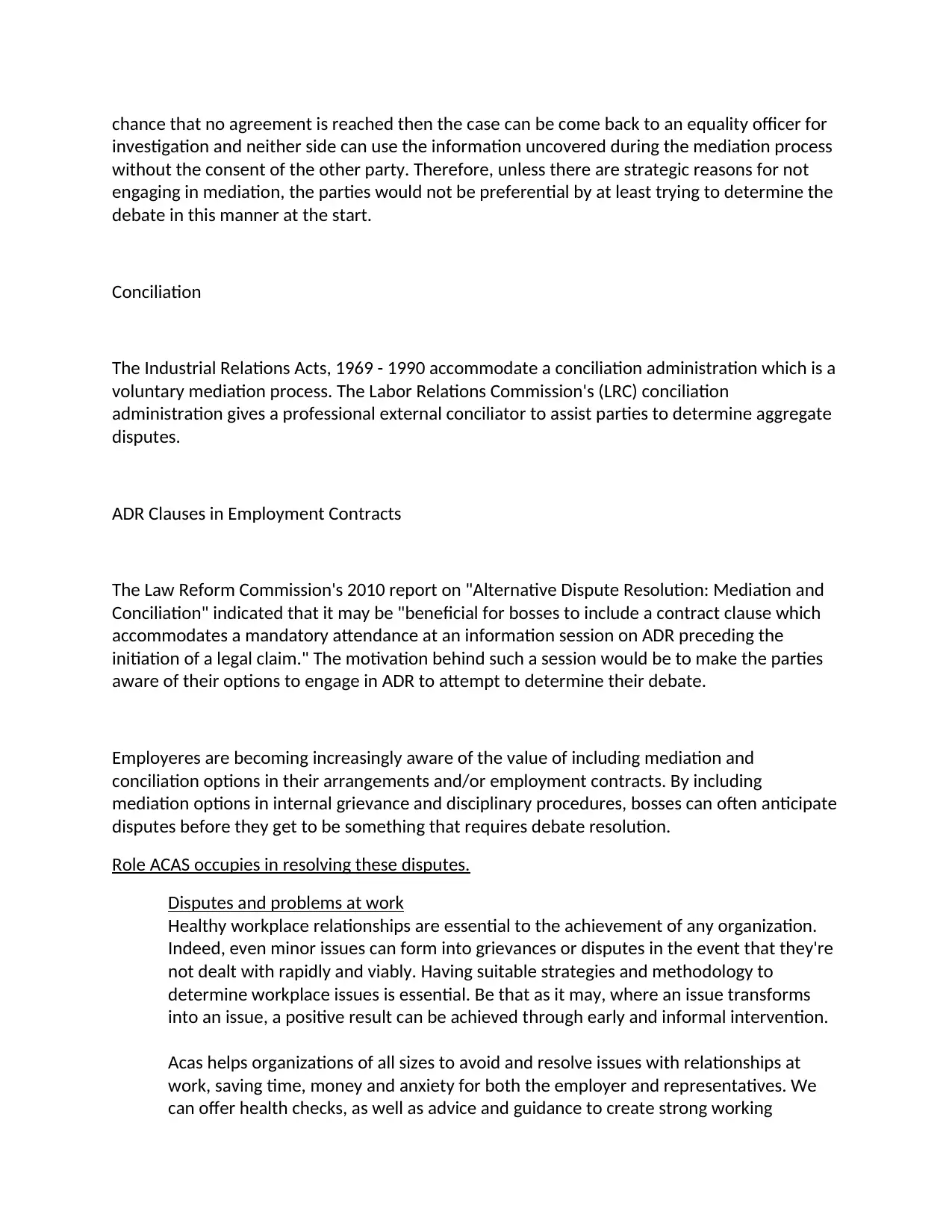
chance that no agreement is reached then the case can be come back to an equality officer for
investigation and neither side can use the information uncovered during the mediation process
without the consent of the other party. Therefore, unless there are strategic reasons for not
engaging in mediation, the parties would not be preferential by at least trying to determine the
debate in this manner at the start.
Conciliation
The Industrial Relations Acts, 1969 - 1990 accommodate a conciliation administration which is a
voluntary mediation process. The Labor Relations Commission's (LRC) conciliation
administration gives a professional external conciliator to assist parties to determine aggregate
disputes.
ADR Clauses in Employment Contracts
The Law Reform Commission's 2010 report on "Alternative Dispute Resolution: Mediation and
Conciliation" indicated that it may be "beneficial for bosses to include a contract clause which
accommodates a mandatory attendance at an information session on ADR preceding the
initiation of a legal claim." The motivation behind such a session would be to make the parties
aware of their options to engage in ADR to attempt to determine their debate.
Employeres are becoming increasingly aware of the value of including mediation and
conciliation options in their arrangements and/or employment contracts. By including
mediation options in internal grievance and disciplinary procedures, bosses can often anticipate
disputes before they get to be something that requires debate resolution.
Role ACAS occupies in resolving these disputes.
Disputes and problems at work
Healthy workplace relationships are essential to the achievement of any organization.
Indeed, even minor issues can form into grievances or disputes in the event that they're
not dealt with rapidly and viably. Having suitable strategies and methodology to
determine workplace issues is essential. Be that as it may, where an issue transforms
into an issue, a positive result can be achieved through early and informal intervention.
Acas helps organizations of all sizes to avoid and resolve issues with relationships at
work, saving time, money and anxiety for both the employer and representatives. We
can offer health checks, as well as advice and guidance to create strong working
investigation and neither side can use the information uncovered during the mediation process
without the consent of the other party. Therefore, unless there are strategic reasons for not
engaging in mediation, the parties would not be preferential by at least trying to determine the
debate in this manner at the start.
Conciliation
The Industrial Relations Acts, 1969 - 1990 accommodate a conciliation administration which is a
voluntary mediation process. The Labor Relations Commission's (LRC) conciliation
administration gives a professional external conciliator to assist parties to determine aggregate
disputes.
ADR Clauses in Employment Contracts
The Law Reform Commission's 2010 report on "Alternative Dispute Resolution: Mediation and
Conciliation" indicated that it may be "beneficial for bosses to include a contract clause which
accommodates a mandatory attendance at an information session on ADR preceding the
initiation of a legal claim." The motivation behind such a session would be to make the parties
aware of their options to engage in ADR to attempt to determine their debate.
Employeres are becoming increasingly aware of the value of including mediation and
conciliation options in their arrangements and/or employment contracts. By including
mediation options in internal grievance and disciplinary procedures, bosses can often anticipate
disputes before they get to be something that requires debate resolution.
Role ACAS occupies in resolving these disputes.
Disputes and problems at work
Healthy workplace relationships are essential to the achievement of any organization.
Indeed, even minor issues can form into grievances or disputes in the event that they're
not dealt with rapidly and viably. Having suitable strategies and methodology to
determine workplace issues is essential. Be that as it may, where an issue transforms
into an issue, a positive result can be achieved through early and informal intervention.
Acas helps organizations of all sizes to avoid and resolve issues with relationships at
work, saving time, money and anxiety for both the employer and representatives. We
can offer health checks, as well as advice and guidance to create strong working
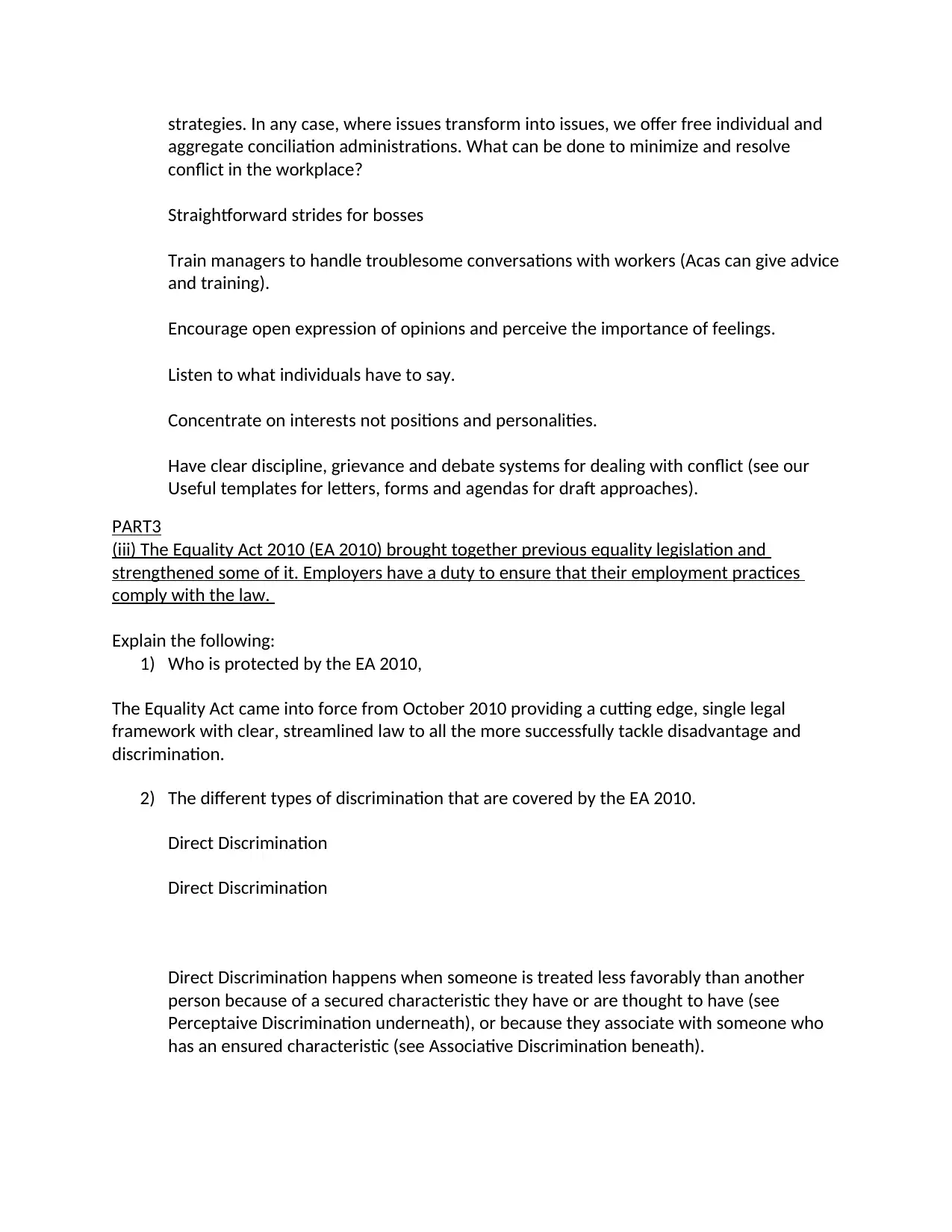
strategies. In any case, where issues transform into issues, we offer free individual and
aggregate conciliation administrations. What can be done to minimize and resolve
conflict in the workplace?
Straightforward strides for bosses
Train managers to handle troublesome conversations with workers (Acas can give advice
and training).
Encourage open expression of opinions and perceive the importance of feelings.
Listen to what individuals have to say.
Concentrate on interests not positions and personalities.
Have clear discipline, grievance and debate systems for dealing with conflict (see our
Useful templates for letters, forms and agendas for draft approaches).
PART3
(iii) The Equality Act 2010 (EA 2010) brought together previous equality legislation and
strengthened some of it. Employers have a duty to ensure that their employment practices
comply with the law.
Explain the following:
1) Who is protected by the EA 2010,
The Equality Act came into force from October 2010 providing a cutting edge, single legal
framework with clear, streamlined law to all the more successfully tackle disadvantage and
discrimination.
2) The different types of discrimination that are covered by the EA 2010.
Direct Discrimination
Direct Discrimination
Direct Discrimination happens when someone is treated less favorably than another
person because of a secured characteristic they have or are thought to have (see
Perceptaive Discrimination underneath), or because they associate with someone who
has an ensured characteristic (see Associative Discrimination beneath).
aggregate conciliation administrations. What can be done to minimize and resolve
conflict in the workplace?
Straightforward strides for bosses
Train managers to handle troublesome conversations with workers (Acas can give advice
and training).
Encourage open expression of opinions and perceive the importance of feelings.
Listen to what individuals have to say.
Concentrate on interests not positions and personalities.
Have clear discipline, grievance and debate systems for dealing with conflict (see our
Useful templates for letters, forms and agendas for draft approaches).
PART3
(iii) The Equality Act 2010 (EA 2010) brought together previous equality legislation and
strengthened some of it. Employers have a duty to ensure that their employment practices
comply with the law.
Explain the following:
1) Who is protected by the EA 2010,
The Equality Act came into force from October 2010 providing a cutting edge, single legal
framework with clear, streamlined law to all the more successfully tackle disadvantage and
discrimination.
2) The different types of discrimination that are covered by the EA 2010.
Direct Discrimination
Direct Discrimination
Direct Discrimination happens when someone is treated less favorably than another
person because of a secured characteristic they have or are thought to have (see
Perceptaive Discrimination underneath), or because they associate with someone who
has an ensured characteristic (see Associative Discrimination beneath).

Associative Discrimination
This already applies to Race, Religion or Belief and Sexual Orientation. It is presently
reached out to cover Age, Disability, Gender Reassignment and Sex. This is immediate
discrimination against someone because they associate with another person who has an
ensured characteristic.
Keen Discrimination
This already applies to Age, Race, Religion or Belief and Sexual Orientation. It is
presently reached out to cover Disability, Gender Reassignment and Sex. This is
immediate discrimination against an individual because others think they have a
particular ensured characteristic. It applies regardless of the possibility that the person
does not actually have the characteristic.
Indirect Discrimination
This already applies to Age, Race, Religion or Belief, Sex, Sexual Orientation and
Marriage and Civil Partnership. It is presently stretched out to cover Disability and
Gender Reassignment.
Indirect Discrimination can happen when you have a condition, guideline, arrangement
or even a practice in your organization that applies to everyone except particularly
disadvantages individuals who share a secured characteristic.
Harassment
This already applies to Race, Religion or Belief and Sexual Orientation. It is presently
reached out to cover Age, Disability, Gender Reassignment and Sex. This is immediate
discrimination against someone because they associate with another person who has an
ensured characteristic.
Keen Discrimination
This already applies to Age, Race, Religion or Belief and Sexual Orientation. It is
presently reached out to cover Disability, Gender Reassignment and Sex. This is
immediate discrimination against an individual because others think they have a
particular ensured characteristic. It applies regardless of the possibility that the person
does not actually have the characteristic.
Indirect Discrimination
This already applies to Age, Race, Religion or Belief, Sex, Sexual Orientation and
Marriage and Civil Partnership. It is presently stretched out to cover Disability and
Gender Reassignment.
Indirect Discrimination can happen when you have a condition, guideline, arrangement
or even a practice in your organization that applies to everyone except particularly
disadvantages individuals who share a secured characteristic.
Harassment
Secure Best Marks with AI Grader
Need help grading? Try our AI Grader for instant feedback on your assignments.
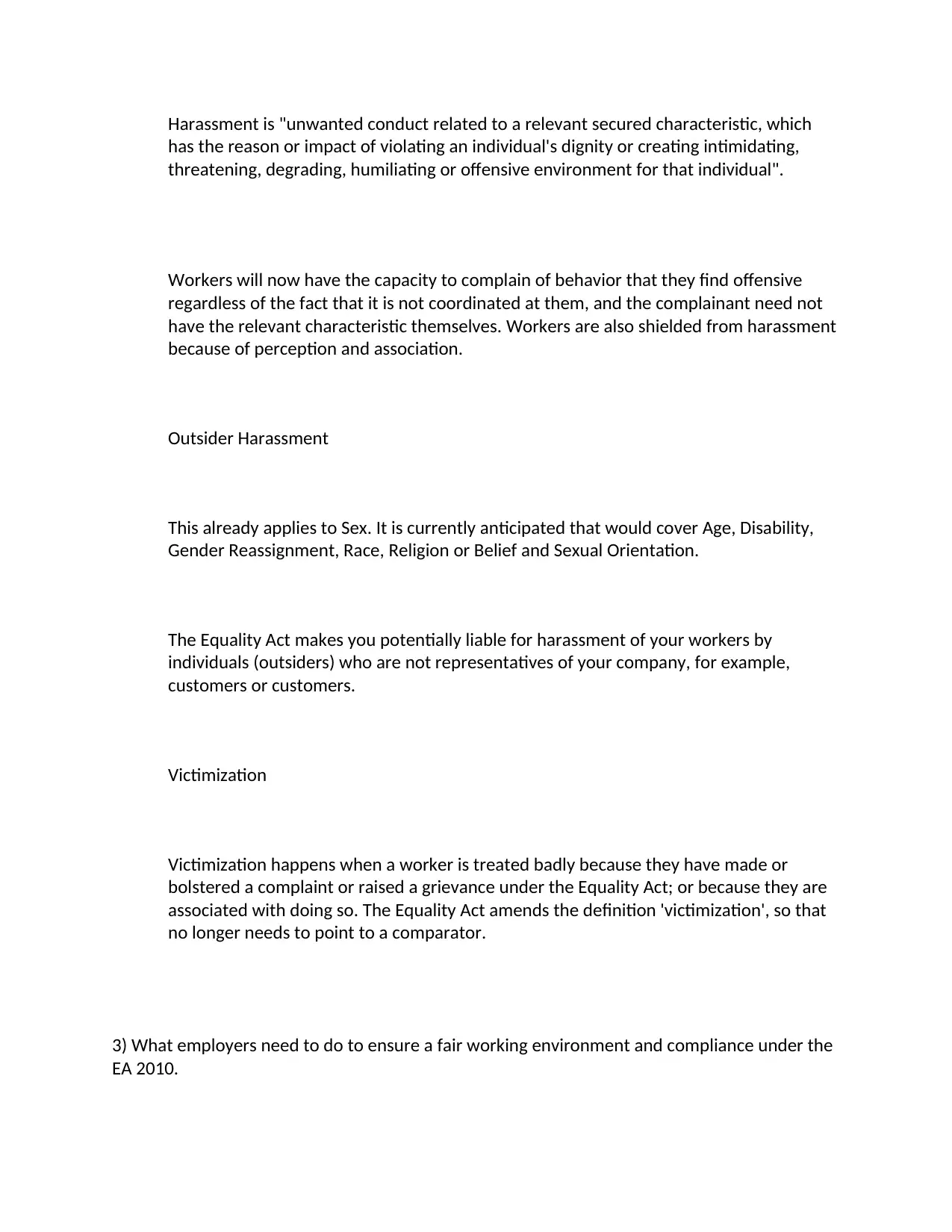
Harassment is "unwanted conduct related to a relevant secured characteristic, which
has the reason or impact of violating an individual's dignity or creating intimidating,
threatening, degrading, humiliating or offensive environment for that individual".
Workers will now have the capacity to complain of behavior that they find offensive
regardless of the fact that it is not coordinated at them, and the complainant need not
have the relevant characteristic themselves. Workers are also shielded from harassment
because of perception and association.
Outsider Harassment
This already applies to Sex. It is currently anticipated that would cover Age, Disability,
Gender Reassignment, Race, Religion or Belief and Sexual Orientation.
The Equality Act makes you potentially liable for harassment of your workers by
individuals (outsiders) who are not representatives of your company, for example,
customers or customers.
Victimization
Victimization happens when a worker is treated badly because they have made or
bolstered a complaint or raised a grievance under the Equality Act; or because they are
associated with doing so. The Equality Act amends the definition 'victimization', so that
no longer needs to point to a comparator.
3) What employers need to do to ensure a fair working environment and compliance under the
EA 2010.
has the reason or impact of violating an individual's dignity or creating intimidating,
threatening, degrading, humiliating or offensive environment for that individual".
Workers will now have the capacity to complain of behavior that they find offensive
regardless of the fact that it is not coordinated at them, and the complainant need not
have the relevant characteristic themselves. Workers are also shielded from harassment
because of perception and association.
Outsider Harassment
This already applies to Sex. It is currently anticipated that would cover Age, Disability,
Gender Reassignment, Race, Religion or Belief and Sexual Orientation.
The Equality Act makes you potentially liable for harassment of your workers by
individuals (outsiders) who are not representatives of your company, for example,
customers or customers.
Victimization
Victimization happens when a worker is treated badly because they have made or
bolstered a complaint or raised a grievance under the Equality Act; or because they are
associated with doing so. The Equality Act amends the definition 'victimization', so that
no longer needs to point to a comparator.
3) What employers need to do to ensure a fair working environment and compliance under the
EA 2010.
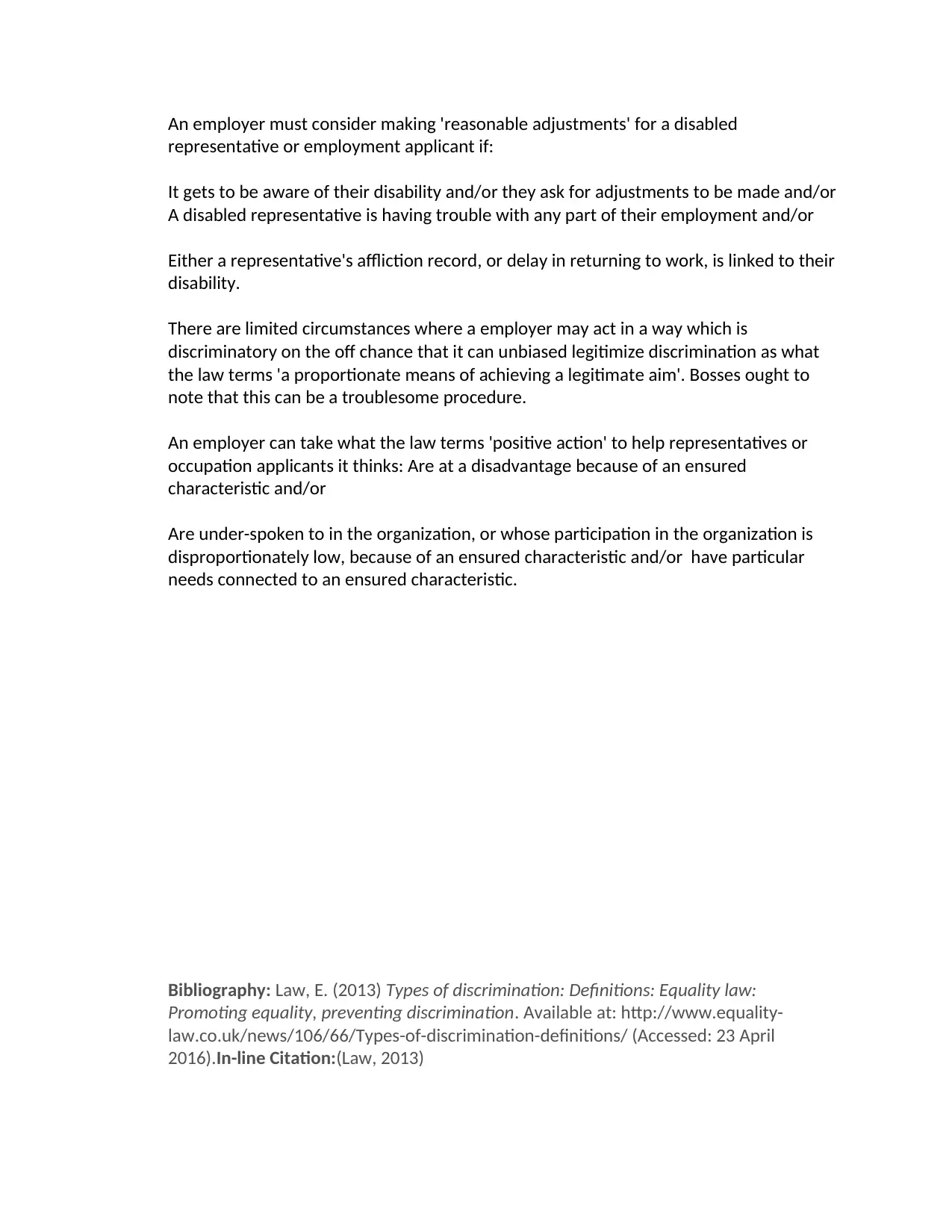
An employer must consider making 'reasonable adjustments' for a disabled
representative or employment applicant if:
It gets to be aware of their disability and/or they ask for adjustments to be made and/or
A disabled representative is having trouble with any part of their employment and/or
Either a representative's affliction record, or delay in returning to work, is linked to their
disability.
There are limited circumstances where a employer may act in a way which is
discriminatory on the off chance that it can unbiased legitimize discrimination as what
the law terms 'a proportionate means of achieving a legitimate aim'. Bosses ought to
note that this can be a troublesome procedure.
An employer can take what the law terms 'positive action' to help representatives or
occupation applicants it thinks: Are at a disadvantage because of an ensured
characteristic and/or
Are under-spoken to in the organization, or whose participation in the organization is
disproportionately low, because of an ensured characteristic and/or have particular
needs connected to an ensured characteristic.
Bibliography: Law, E. (2013) Types of discrimination: Definitions: Equality law:
Promoting equality, preventing discrimination. Available at: http://www.equality-
law.co.uk/news/106/66/Types-of-discrimination-definitions/ (Accessed: 23 April
2016).In-line Citation:(Law, 2013)
representative or employment applicant if:
It gets to be aware of their disability and/or they ask for adjustments to be made and/or
A disabled representative is having trouble with any part of their employment and/or
Either a representative's affliction record, or delay in returning to work, is linked to their
disability.
There are limited circumstances where a employer may act in a way which is
discriminatory on the off chance that it can unbiased legitimize discrimination as what
the law terms 'a proportionate means of achieving a legitimate aim'. Bosses ought to
note that this can be a troublesome procedure.
An employer can take what the law terms 'positive action' to help representatives or
occupation applicants it thinks: Are at a disadvantage because of an ensured
characteristic and/or
Are under-spoken to in the organization, or whose participation in the organization is
disproportionately low, because of an ensured characteristic and/or have particular
needs connected to an ensured characteristic.
Bibliography: Law, E. (2013) Types of discrimination: Definitions: Equality law:
Promoting equality, preventing discrimination. Available at: http://www.equality-
law.co.uk/news/106/66/Types-of-discrimination-definitions/ (Accessed: 23 April
2016).In-line Citation:(Law, 2013)
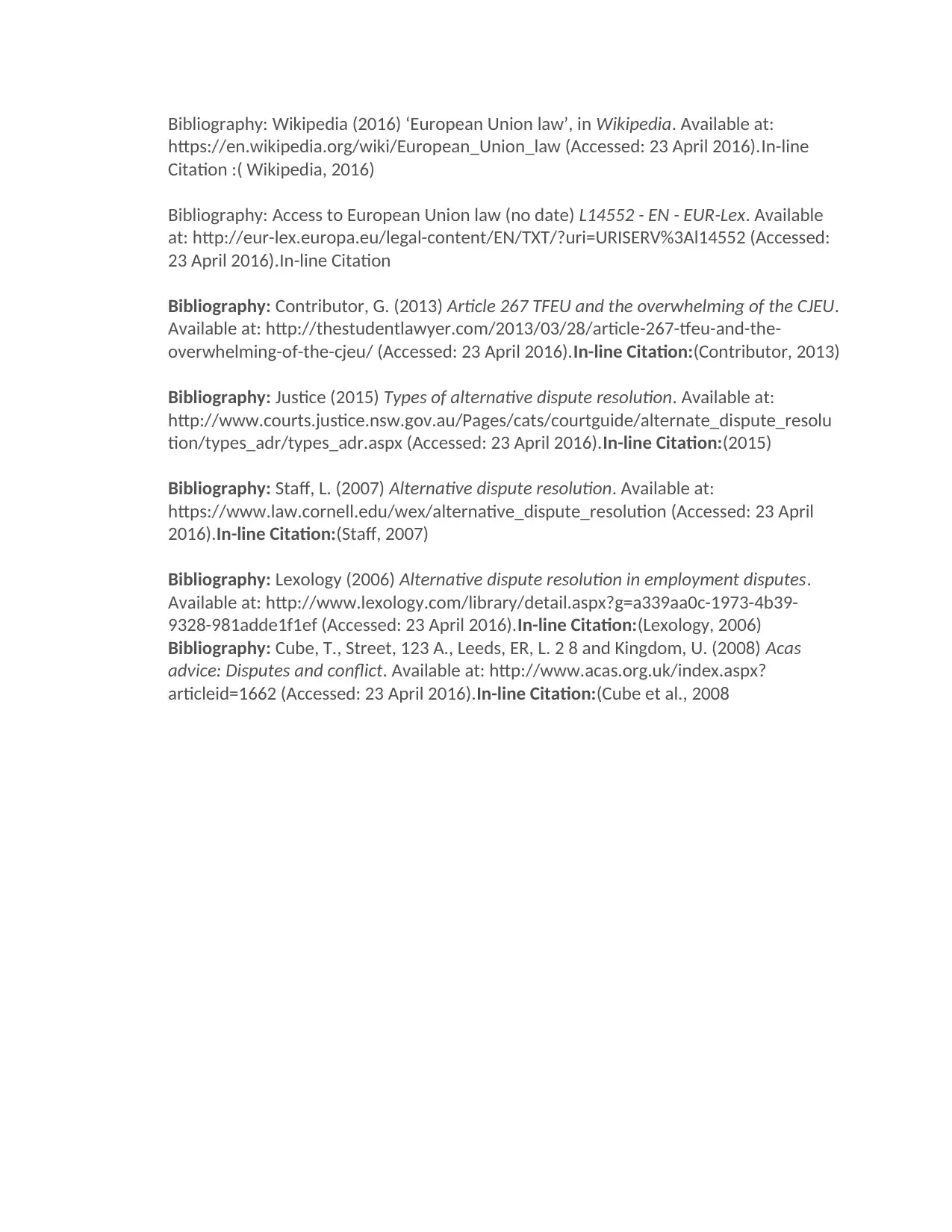
Bibliography: Wikipedia (2016) ‘European Union law’, in Wikipedia. Available at:
https://en.wikipedia.org/wiki/European_Union_law (Accessed: 23 April 2016).In-line
Citation :( Wikipedia, 2016)
Bibliography: Access to European Union law (no date) L14552 - EN - EUR-Lex. Available
at: http://eur-lex.europa.eu/legal-content/EN/TXT/?uri=URISERV%3Al14552 (Accessed:
23 April 2016).In-line Citation
Bibliography: Contributor, G. (2013) Article 267 TFEU and the overwhelming of the CJEU.
Available at: http://thestudentlawyer.com/2013/03/28/article-267-tfeu-and-the-
overwhelming-of-the-cjeu/ (Accessed: 23 April 2016).In-line Citation:(Contributor, 2013)
Bibliography: Justice (2015) Types of alternative dispute resolution. Available at:
http://www.courts.justice.nsw.gov.au/Pages/cats/courtguide/alternate_dispute_resolu
tion/types_adr/types_adr.aspx (Accessed: 23 April 2016).In-line Citation:(2015)
Bibliography: Staff, L. (2007) Alternative dispute resolution. Available at:
https://www.law.cornell.edu/wex/alternative_dispute_resolution (Accessed: 23 April
2016).In-line Citation:(Staff, 2007)
Bibliography: Lexology (2006) Alternative dispute resolution in employment disputes.
Available at: http://www.lexology.com/library/detail.aspx?g=a339aa0c-1973-4b39-
9328-981adde1f1ef (Accessed: 23 April 2016).In-line Citation:(Lexology, 2006)
Bibliography: Cube, T., Street, 123 A., Leeds, ER, L. 2 8 and Kingdom, U. (2008) Acas
advice: Disputes and conflict. Available at: http://www.acas.org.uk/index.aspx?
articleid=1662 (Accessed: 23 April 2016).In-line Citation:(Cube et al., 2008
https://en.wikipedia.org/wiki/European_Union_law (Accessed: 23 April 2016).In-line
Citation :( Wikipedia, 2016)
Bibliography: Access to European Union law (no date) L14552 - EN - EUR-Lex. Available
at: http://eur-lex.europa.eu/legal-content/EN/TXT/?uri=URISERV%3Al14552 (Accessed:
23 April 2016).In-line Citation
Bibliography: Contributor, G. (2013) Article 267 TFEU and the overwhelming of the CJEU.
Available at: http://thestudentlawyer.com/2013/03/28/article-267-tfeu-and-the-
overwhelming-of-the-cjeu/ (Accessed: 23 April 2016).In-line Citation:(Contributor, 2013)
Bibliography: Justice (2015) Types of alternative dispute resolution. Available at:
http://www.courts.justice.nsw.gov.au/Pages/cats/courtguide/alternate_dispute_resolu
tion/types_adr/types_adr.aspx (Accessed: 23 April 2016).In-line Citation:(2015)
Bibliography: Staff, L. (2007) Alternative dispute resolution. Available at:
https://www.law.cornell.edu/wex/alternative_dispute_resolution (Accessed: 23 April
2016).In-line Citation:(Staff, 2007)
Bibliography: Lexology (2006) Alternative dispute resolution in employment disputes.
Available at: http://www.lexology.com/library/detail.aspx?g=a339aa0c-1973-4b39-
9328-981adde1f1ef (Accessed: 23 April 2016).In-line Citation:(Lexology, 2006)
Bibliography: Cube, T., Street, 123 A., Leeds, ER, L. 2 8 and Kingdom, U. (2008) Acas
advice: Disputes and conflict. Available at: http://www.acas.org.uk/index.aspx?
articleid=1662 (Accessed: 23 April 2016).In-line Citation:(Cube et al., 2008
Paraphrase This Document
Need a fresh take? Get an instant paraphrase of this document with our AI Paraphraser



1 out of 16
Related Documents
Your All-in-One AI-Powered Toolkit for Academic Success.
+13062052269
info@desklib.com
Available 24*7 on WhatsApp / Email
![[object Object]](/_next/static/media/star-bottom.7253800d.svg)
Unlock your academic potential
© 2024 | Zucol Services PVT LTD | All rights reserved.





